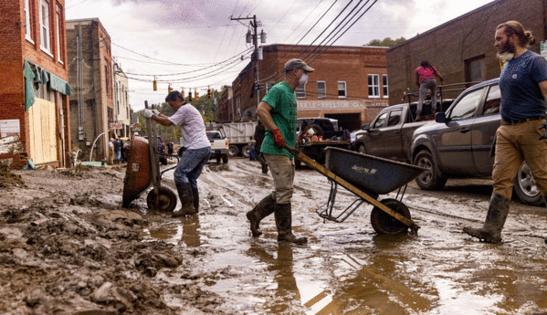Where's the money? Nearly 7 months after Hurricane Helene, NC towns wait on federal checks
Published in News & Features
CHARLOTTE, N.C. — On a recent trip to Washington, D.C., North Carolina town leaders were asked to raise their hands if they had not yet received federal funds to pay for Helene-linked damage to public buildings, roadways and more.
In every meeting with U.S. Senators, House members, the Federal Emergency Management Agency and Trump administration officials, several leaders lifted their arms, signaling a resounding no, said Zeb Smathers, the mayor of Canton.
FEMA has sent hundreds of millions to people in Western North Carolina to help with housing and other needs. But nearly seven months after Helene ravaged towns and cities in Western North Carolina, many towns, like Canton, haven’t seen a dime from FEMA for much needed repairs.
“The money is there,” Smathers said. “It’s the will to act. I’m very tired of excuses.”
In December, Congress appropriated $110 billion for recovery in all states impacted by Helene. North Carolina local governments are expected to receive a share.
Without federal funding, towns like Canton have to figure out how to secure money for projects such as finding a new location for its flooded firehouse. Building a new firehouse is expected to cost $5 million, said Natalie Walker, Canton’s financial officer.
Right now, the town’s fire department is operating out of a double-wide trailer from the Army Corps of Engineers, Smathers said.
When you add up all the costs towns have to clear debris, fix roads and bridges, repair public buildings, fix water plants and more, the combined cost often exceeds their annual budgets, which is the case in Canton.
FEMA is in the process of working with communities who have not received funds, an agency spokesperson said.
“Many projects are in varying levels of the approvals process and we will continue working together with local and state officials to address the needs of their communities,” the spokesperson from FEMA’s North Carolina news desk stated in an email.
Local newsroom dug deep
The Smoky Mountain News was first to document the scale of the problem. Reporter Cory Vaillancourt collected data from 23 municipalities on how much money they received from FEMA versus the amount of damage they incurred.
His analysis found that only nine local governments had received any funding. This money is needed to fix things like the town of Marshall’s sewage treatment plant, repair public buildings in Canton and more.
Many small governments don’t have the budgets to pay for needed repairs without the help of the federal government, Vaillancourt found.
“You can’t solve that with fund balance. You can’t solve that with tiny cuts to different departments of your town,” Vaillancourt said. “You can’t diminish your services and say, ‘Well, we’re going to fire half the cops to save money.’ So there’s really no way to write around any of this.”
Slow process
Montreat Mayor Tim Helms said about 10 FEMA employees visited his community just a few weeks ago.
They focused on three roads —Assembly Drive, Greybeard Trail and Appalachian Way — that Helene’s floodwaters had washed away. While the city has worked to make the roads passable, the repairs were meant to be temporary. Each road will take about $1 million to fix, Helms said
Paperwork had already been submitted to FEMA for the patchwork they were able to complete on the roads. But getting them paved and up to permanent acceptable standards is going to take time and money, the mayor said.
Each FEMA representative had a different specialty: construction, engineering and finance to name a few. And all took more photos that Helms could count.
But once they left, the work to apply for aid wasn’t over. Staff had to complete paperwork and sometimes go back and forth with FEMA representatives if “you did not dot an I or cross a T.”
“I’m sure there’s a lot of fraud in instances like these natural disasters, where people apply for funds (to fix) everything that was broken in the town,” he said. “We’re not asking for that. We’re asking just to fix just what is damaged.”
Living with two disasters
The disaster recovery process is painfully slow and can be extremely convoluted for those who’ve never gone through the process before, those with experience say.
It can take up to five years for communities to be made whole, according to Tony McEwan, Carolinas Director at the American Flood Coalition.
“Because the federal system is split across dozens of agencies and more than a hundred different programs, it takes far too long to get money out the door, even once it’s been appropriated,” McEwan wrote in an email to The Observer.
Some larger local governments like Asheville have hired firms to help them navigate the process, said Nathan Ramsay, director of the council’s Mountain Area Workforce Development Board. Others are being helped by the Land of Sky Regional Council, he said.
“I’ve been told the first disaster is the disaster you know that impacts your community,” he said. “The second disaster is trying to deal with the bureaucracy of trying to respond to the disaster.”
U.S. Rep. Chuck Edwards, a Republican representing North Carolina’s 11th district, on April 15 released a 62-page report to President Trump focused on recommendations to improve FEMA. Delivery the agency’s Helene recovery aid could be accelerated in several ways, the report argues, including:
—Calling for the immediate payment for all FEMA reimbursements for debris removal and emergency protective measures.
—Eliminating or consolidating duplicative FEMA programs and providing
—Introducing more flexibility around FEMA disaster loan programs
“The complex process currently in place has slowed Western North Carolina’s recovery from Hurricane Helene and will continue to do so if immediate steps are not taken to streamline recovery,” the report says.
Tricky budgets
The lack of federal reimbursements comes at a tricky time for local governments who are preparing to create budgets for the upcoming fiscal year.
As local governments build their budgets, they are also facing cash shortfalls from the loss of leaf season last all — the most popular tourism season in Western North Carolina, said state Sen. Julie Mayfield, a Democrat who represents Buncombe County.
To make up for this, some will have to weigh cuts to staff or consider raising taxes.
“There’s very little that local governments can do to ensure they have the revenue they need,” she said, adding: “They don’t control the spigot on the federal money and they don’t control what state money is available to them right now.”
If the past predicts the future, these leaders could wait on government aid for a long time.
The town of Canton has still not received $1 million expected from FEMA to help pay for trailers the town leased for temporary shelter to house the police department and town hall, Walker, the town’s CFO said.
Mayor Smathers said he’s past believing promises.
“How can we look anyone in the eye honestly and say your money is going to be here soon?” he asked.
_____
©2025 The Charlotte Observer. Visit at charlotteobserver.com. Distributed by Tribune Content Agency, LLC.







Comments